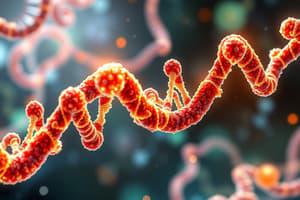Podcast
Questions and Answers
Which of the following statements accurately describes the structure of DNA?
Which of the following statements accurately describes the structure of DNA?
- DNA is a single-stranded helix, with nucleotides connected by hydrogen bonds.
- DNA is a double-stranded helix, with the two strands connected by covalent bonds.
- DNA is a double-stranded helix, with the two strands running in opposite directions (antiparallel). (correct)
- DNA is a double-stranded helix, with the two strands running in the same direction.
What is the significance of Chargaff's rule in DNA structure?
What is the significance of Chargaff's rule in DNA structure?
- It explains the equal ratio of adenine to thymine and guanine to cytosine in DNA. (correct)
- It outlines the process of DNA replication.
- It reveals the helical structure of DNA.
- It describes the sugar-phosphate backbone of DNA.
What is the primary function of DNA?
What is the primary function of DNA?
- To provide structural support to cells.
- To store and transmit genetic information. (correct)
- To catalyze biochemical reactions.
- To transport molecules across cell membranes.
Which of the following is NOT a component of a nucleotide?
Which of the following is NOT a component of a nucleotide?
The central dogma of molecular biology describes the flow of genetic information. Which of the following represents the correct sequence?
The central dogma of molecular biology describes the flow of genetic information. Which of the following represents the correct sequence?
Flashcards
Nucleic Acid
Nucleic Acid
Molecules that store and pass genetic information, including DNA and RNA.
Nucleotide
Nucleotide
The basic building block of nucleic acids, consisting of a sugar, phosphate, and nitrogenous base.
Chargaff’s Rule
Chargaff’s Rule
The principle that DNA's amount of adenine equals thymine, and guanine equals cytosine.
Anti-parallel
Anti-parallel
Signup and view all the flashcards
Central Dogma
Central Dogma
Signup and view all the flashcards
Study Notes
Nucleic Acids
- Nucleic acids are linear polymers that store and pass genetic information
- Two main types: DNA and RNA
- Both DNA and RNA are made up of nucleotides
- Nucleotides consist of a phosphate group, a sugar (deoxyribose in DNA, ribose in RNA), and a nitrogenous base.
Nucleotide Structure
- Nitrogenous bases:
- DNA: Adenine (A), Guanine (G), Cytosine (C), Thymine (T)
- RNA: Adenine (A), Guanine (G), Cytosine (C), Uracil (U)
- Sugar:
- DNA: Deoxyribose
- RNA: Ribose
- Phosphate group: Phosphate group links sugars to form the backbone (phosphodiester linkage)
DNA Structure
- DNA is a double helix structure
- The double helix consists of two antiparallel polynucleotide strands wound around each other.
- The strands run in opposite directions (5' to 3' and 3' to 5')
- Bases pair via hydrogen bonds (A-T, C-G) - Complementary base pairing
RNA Structure
- RNA is single-stranded
- Various types of RNA exist with different functions
- RNA also uses complementary base-pairing (A-U, C-G)
DNA Packaging
- DNA is highly organized within cells
- DNA wraps around proteins called histones to form nucleosomes.
- Nucleosomes coil into a 30 nm fiber, further condensed into higher-order structures to form chromosomes.
Chargaff's Rule
- In a DNA molecule, the amount of adenine equals the amount of thymine, and the amount of cytosine equals the amount of guanine.
Central Dogma
- DNA holds the genetic instructions.
- The central dogma describes the flow of genetic information.
- DNA is replicated to preserve information
- Transcription converts DNA to RNA (mRNA)
- Translation converts RNA to protein
Types of RNA
- mRNA (messenger RNA): Carries genetic information from DNA to ribosomes for protein synthesis
- rRNA (ribosomal RNA): Forms the structure of ribosomes, where protein synthesis occurs
- tRNA (transfer RNA): Brings amino acids to the ribosomes during protein synthesis.
- Other types of RNA: snRNA, snoRNA, miRNA, siRNA, incRNA, etc.
Gene Structure
- A gene is a sequence of DNA that codes for a protein.
- Genes contain exons (coding regions) and introns (non-coding regions).
- The coding region includes regulatory elements (promoter, polyadenylation signal) that control the expression of the gene.
Transcription Process
- The process of copying a gene's DNA sequence into RNA
- Initiation: RNA polymerase binds to the promoter region of the gene
- Elongation: RNA polymerase moves along the DNA template and adds complementary RNA nucleotides to the growing mRNA molecule.
- Termination: RNA polymerase reaches a termination signal and stops transcribing.
Translation Process
- The process of creating a protein from an mRNA molecule.
- mRNA is read in codons (three base sequences). Each codon specifies a particular amino acid.
- tRNA molecules bring the corresponding amino acids to the ribosome.
- Amino acids are linked together by peptide bonds to form a polypeptide chain.
- The polypeptide chain folds into a functional protein.
Genetic Code
- The genetic code is a set of rules that determines how codons in mRNA are translated into amino acids in proteins.
- Most amino acids are specified by more than one codon (redundant code).
- Start and stop codons signal the beginning and end of protein synthesis.
Studying That Suits You
Use AI to generate personalized quizzes and flashcards to suit your learning preferences.




